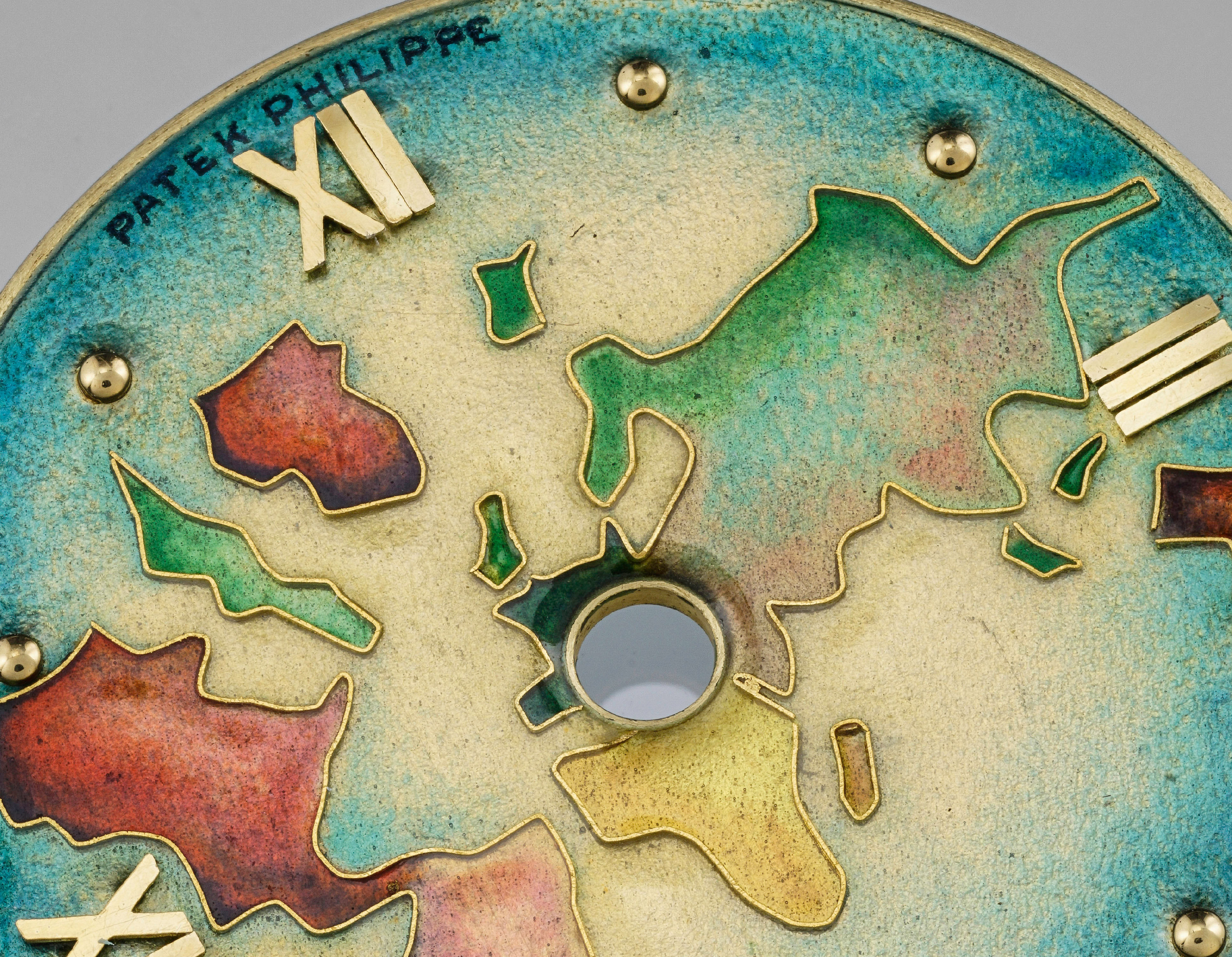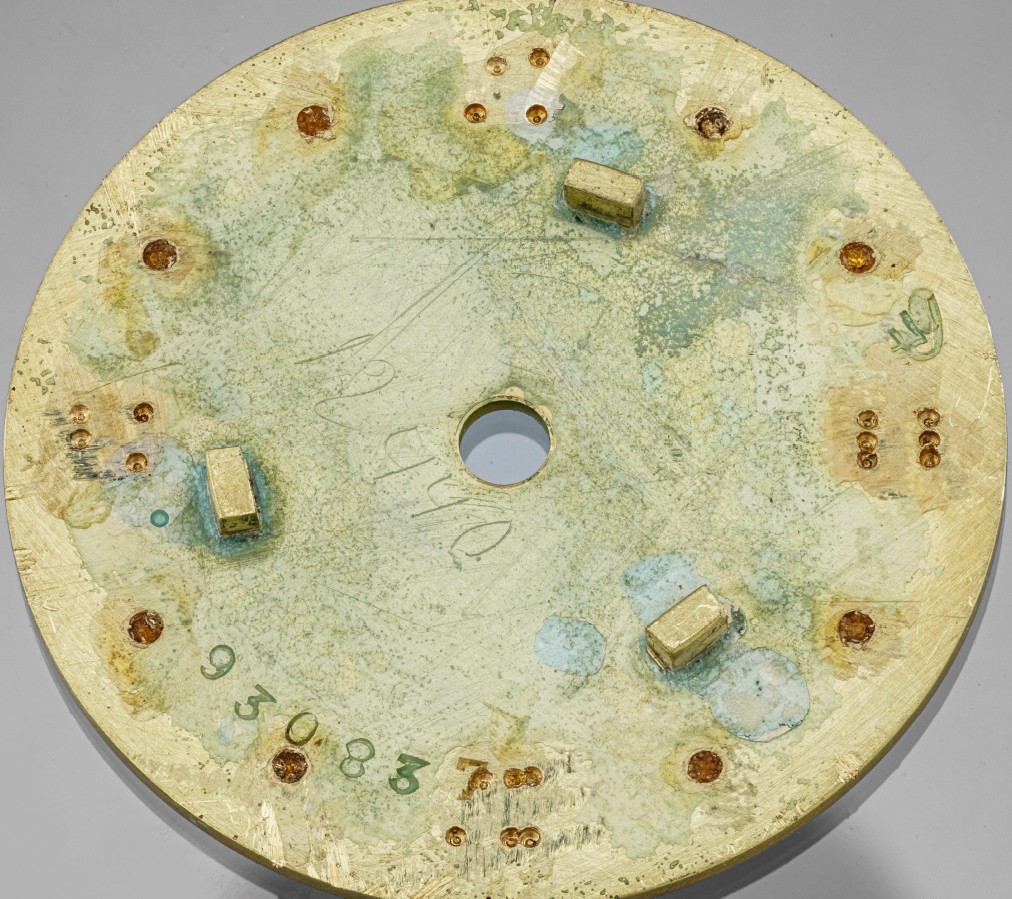









266
Patek Philippe
Ref. 605 HU DE
Worldtime
A highly important and extremely rare yellow gold open face world time pocketwatch with "World Map" polychrome cloisonné enamel dial
Full-Cataloguing
Patek Philippe enameled world time pieces undoubtedly belong in this category. World time watches were serially produced by Patek Philippe from the late 1930s to the 1950s (and then again in modern form from 2000 onward). Disregarding prototype series (such as reference 1416) and piece unique watches (such as “The Doctor’s” world time chronograph or the rectangular-shaped world time watch), three references mainly represent the vintage world time production of the brand: wrist references 1415 and 2523 (and its evolution 2523-1), and the present pocket reference 605 HU, all of them made under the absolute supervision of watchmaker Louis Cottier, inventor of the world time system.
In 1937, Cottier submitted to the company a first offer for a 17’’’ world time movement, and he would eventually create less than 100 movements, most of them cased in reference 605. The model was originally offered with a silver (sometimes champagne or pink) dial, but it was a commercial flop due to the combination of the downhill trend of pocket watches in then-current fashion and the novelty of the world time system, which was met with lukewarm enthusiasm by Patek Philippe clients. This is why it is very common to see years passing between the production date of a 605 HU and its sale: in this case for example, the watch was manufactured in 1948 but sold nearly a decade later, in 1956.
Such a low demand is probably what prompted Patek Philippe to offer a new and more luxurious dial option: the celebrated polychrome cloisonné enamel dial, available from the late 1940s. The new option, however, did not truly help to overturn the poor commercial performance of the model, which could also be explained by the complicated production process leading to a very slow production rate, thus it was physically impossible to achieve high volumes. Furthermore, the presence of a cloisonné dial commanded an enormous increase of price: when a standard pocket watch of similar size to ref. 605 was at the time retailing for about 870 CHF, reference 605 HU cloisonné was being sold for a whopping 2’250 CHF; while part of the price increase was due to the complicated movement, most of it was due to the dial. As a result, such watches were made in extremely restricted numbers, with around ten pieces publicly known today. The offer spaced from the traditional geographic maps to more unusual subjects, such as the “Neptune" or the “Compass". The World Map here exemplified is an exceedingly rare design, with only another example known to the market.
It appears that some examples of reference 605 which were born with a metal dial were later upgraded to the enamel version. Such is the case of the present watch: while the Patek Philippe Extract does not bear mention of the enamel dial, the presence of the movement number stamped to the back of the enamel disc indisputably links dial and watch together, the only conclusion being that this was an upgrade made by the manufacturer. Interestingly, a similar situation is known in regard to another reference 605, bearing movement number 930’838: the immediate next movement. An educated guess suggests the presence of a batch of standard-dial pieces which was upgraded with the cloisonné decor.
When analyzing the back of the enamel disc, one can notice on the opposite side from where the movement number is stamped another mark, which would look like an unusual glyph to an untrained eye. In fact, that is the stamp of Louis Cottier (an interlaced L an C). Connoisseurs of watchmaking will find it surprising for a watchmaker to sign a dial, which is not made by the watchmaker. In fact, due to the mechanical connections of the revolving bezel and dial to the world time mechanism, Cottier himself supervised every single production passage for these pieces, and thus the back of the dial bear his mark.
The historical interest and rarity of this ref. 605 version are matched - and suprassed - by the astonishing beauty of the dial. It is interesting to point out how the enamel decor present on this reference is the largest cloisonné dial to be found on a vintage Patek Philippe wrist or pocket timepiece, measuring about 22mm in diameter, compared to the circa 16mm of reference 2523.
Patek Philippe
Swiss | 1839Since its founding in 1839, this famous Geneva-based firm has been surprising its clientele with superbly crafted timepieces fitted with watchmaking's most prestigious complications. Traditional and conservative designs are found across Patek Philippe's watches made throughout their history — the utmost in understated elegance.
Well-known for the Graves Supercomplication — a highly complicated pocket watch that was the world’s most complicated watch for 50 years — this family-owned brand has earned a reputation of excellence around the world. Patek's complicated vintage watches hold the highest number of world records for results achieved at auction compared with any other brand. For collectors, key models include the reference 1518, the world's first serially produced perpetual calendar chronograph, and its successor, the reference 2499. Other famous models include perpetual calendars such as the ref. 1526, ref. 3448 and 3450, chronographs such as the reference 130, 530 and 1463, as well as reference 1436 and 1563 split seconds chronographs. Patek is also well-known for their classically styled, time-only "Calatrava" dress watches, and the "Nautilus," an iconic luxury sports watch first introduced in 1976 as the reference 3700 that is still in production today.